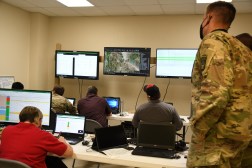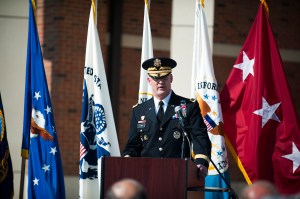Virtualization the way of the future for Pentagon, DISA director says

Software is in and hardware is out at the Pentagon.
The Defense Department is making a greater push to software-based virtualization for its networks and data centers, Lt. Gen. Alan Lynn, director of the Defense Information Systems Agency, shared at DISA’s Forecast to Industry event Monday.
Software-defined networking — which Lynn described as “instead of having hardware … it’s building a huge network just with software” — not only costs less for a capital investment, but it’s also a more agile technology.
“It’s easier to defend a network if you can build multiple, equal networks that are identical in a row,” he said. “And then if you have an attack on one of the networks, you can fold that network and move your users over to the next network.”
In doing so, Lynn said DOD will be able to hop from network to identical virtual network constantly, much like modern radios can jump to better frequencies.
“You can’t have a persistent attack if the network isn’t persistent, if it’s constantly moving,” he said.
The Joint Service Provider — a relatively new, consolidated arm of DISA that provides IT specifically within the National Capital Region — issued a request for information in October hoping to “improve how JSP can successfully implement a Software Defined Network (SDN) solution and modernize the DoD network,” FedScoop reported.
On the data center side, virtualization allows the Pentagon to “spin up a capability whenever we need it,” Lynn explained — again leading to cost savings and added speed.
The true power of these capabilities comes from their combination, he said, pointing to the particular example of multinational information sharing with the U.S.’s allies.
“We do not fight our nation’s wars by ourselves,” said Lynn, a FedScoop 50 award winner for 2017. “We always have a coalition partner. … We think we have an opportunity combining these requirements together to provide an all new type of international network for whoever comes to the fight.”
Typically, the sharing of such networks causes problems to arise around the various allies demanding total control over their networks. With virtualization, that’s possible, the DISA director explained.
“With software-defined networking, they have that opportunity. They can actually hold on to, control their portion of that network,” Lynn said. “And then we connect those networks with this larger network — think of it as it as kind of a universal bus that everybody connects into.”
No matter the ally or location, “we’ll be able to connect them through the virtual data center using software-defined networks and connect all the different forces to do constant sharing with whatever nation shows up for the fight,” he said. “And they can decide what they want to share and what they don’t want to share.”






